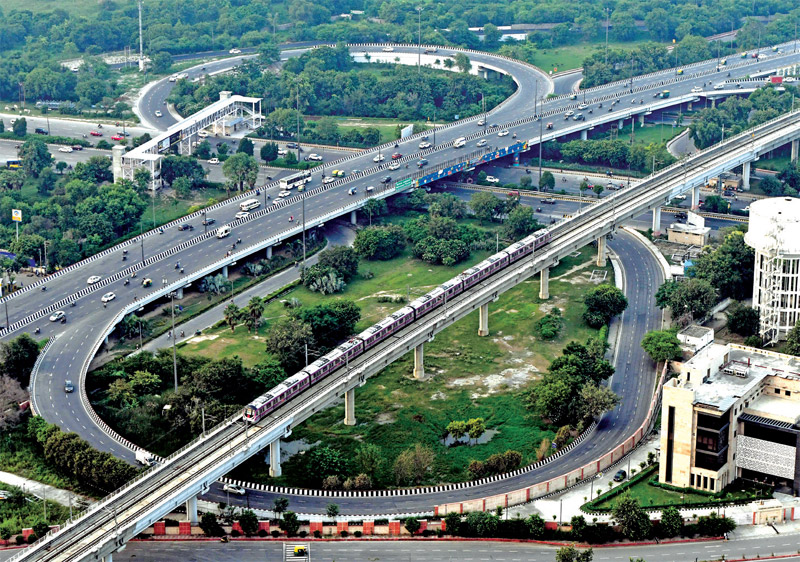Regularly updating cybersecurity measures will enable India secure its digital assets, preserve sovereignty
Antara Jha
In today’s interconnected world, the threat of cyber espionage looms large, posing significant challenges to nations across the globe. As technology advances and information becomes increasingly digital, the potential for malicious actors to infiltrate sensitive networks grows. India, as a rising power in the digital era, faces its own set of vulnerabilities in this realm.

In recent years, numerous high-profile cyber-attacks have occurred, capturing global attention and highlighting the urgent need for robust cybersecurity measures. These real-time examples serve as cautionary tales, illustrating the potential consequences of cyber espionage and the evolving landscape of cyber threats.
One of the most notorious cyber-attacks in history is the Stuxnet worm, discovered in 2010. It targeted Iran’s nuclear programme, specifically the centrifuges used for uranium enrichment. Stuxnet infiltrated the systems through USB drives and exploited zero-day vulnerabilities to cause physical damage to the equipment, setting back Iran’s nuclear ambitions. This attack showcased the potential for cyber warfare to impact critical infrastructure and demonstrated the increasing sophistication of state-sponsored cyber-attacks.
Another prominent example is the WannaCry ransomware attack of 2017. It spread rapidly across the globe, infecting hundreds of thousands of computers in more than 150 countries. The attack exploited a vulnerability in the Windows operating system, encrypting users’ files and demanding ransom payments in cryptocurrency. The widespread impact of WannaCry underscored the vulnerability of both individuals and organisations to large-scale cyber-attacks.
The NotPetya attack, also in 2017, is another significant cyber incident. Initially disguised as ransomware, it quickly became evident that its primary purpose was to cause widespread disruption rather than financial gain. NotPetya targeted Ukrainian businesses, banks, government agencies and eventually spread to companies worldwide. The attack caused billions of dollars in damages and demonstrated the potential for cyber-attacks to have severe economic and geopolitical consequences.
Furthermore, the ongoing series of cyber espionage campaigns attributed to advanced persistent threat groups, such as APT29 (Cozy Bear) and APT28 (Fancy Bear), have highlighted the persistent and pervasive nature of state-sponsored cyber intrusions. These groups have been implicated in high-profile incidents, including the hacking of the Democratic National Committee during the 2016 US presidential election. Such incidents reveal the role of cyber-attacks in influencing political processes and undermining public trust.
These examples, along with others like the Equifax data breach, the Yahoo hack and the Mirai botnet attack, showcase the evolving nature and increasing sophistication of cyber threats. They serve as reminders that no nation, including India, is immune to the risks posed by cyber espionage. By understanding these challenges and examining the vulnerabilities faced by India, we can develop effective strategies to fortify our defences, mitigate risks, and protect sensitive information, critical infrastructure and overall national security.

Cyber Espionage
Cyber espionage entails the covert acquisition of sensitive information or intellectual property by unauthorised means, such as breaching computer systems or networks. Perpetrators of cyber espionage are frequently state-sponsored actors or advanced persistent threats (APTs) with sophisticated capabilities. Their targets encompass a wide array of entities, including governments, defence establishments, research institutions and critical infrastructure.
The motives behind cyber espionage are diverse. Nation-states engage in such activities to gain a competitive advantage, acquire military or technological secrets, or gather intelligence on political, economic or diplomatic matters. By infiltrating computer systems and networks, these actors seek to exploit vulnerabilities and extract valuable data without detection.
Sophisticated techniques like spear-phishing, malware propagation and zero-day exploits are commonly employed in cyber espionage operations. Perpetrators often invest considerable resources in designing tailored attacks, using social engineering tactics and establishing persistent access to targeted networks for long-term intelligence gathering.
The impact of successful cyber espionage can be significant, ranging from economic losses and compromised national security to damaged reputations and compromised privacy. Protecting against cyber espionage requires a multi-faceted approach involving robust cybersecurity measures, regular threat assessments, employee training, information sharing between public and private sectors, and international cooperation to track, identify and bring the perpetrators to justice.
By understanding the nature of cyber espionage and recognising the entities most at risk, India can fortify its defences, strengthen its cybersecurity infrastructure and establish effective incident response mechanisms. Heightened awareness, continuous monitoring and proactive defence measures are imperative to mitigate the threats posed by cyber espionage and safeguard the nation’s sensitive information, critical infrastructure and overall national security.

India’s Vulnerabilities
India’s growing dependence on digital infrastructure, combined with its strategic significance, renders it an appealing target for cyber espionage. Numerous vulnerabilities expose India to potential breaches. Outdated systems, which are prevalent in various sectors, create entry points for malicious actors to exploit. Additionally, inadequate cybersecurity awareness among individuals and organizations further amplifies the risk. A lack of coordination among stakeholders hampers the development of a unified defence strategy, leaving gaps that can be exploited.
Moreover, India’s vast population and diverse digital landscape pose additional challenges. With over a billion people and a wide range of digital devices in use, securing the entirety of this ecosystem becomes a complex task. Ensuring robust cybersecurity measures across different regions, sectors and demographics requires a comprehensive approach.
To address these vulnerabilities, India must adopt a multi-pronged strategy. Upgrading and modernising outdated systems is crucial to eliminate vulnerabilities stemming from legacy infrastructure. Enhancing cybersecurity awareness through education and training initiatives at all levels can empower individuals to recognise and respond to potential threats. Moreover, fostering collaboration and coordination among government agencies, private organisations and international partners is essential for sharing threat intelligence and responding effectively to cyber espionage attempts.
Furthermore, leveraging advanced technologies such as artificial intelligence and machine learning can enhance India’s defence capabilities. These technologies can bolster threat detection and response mechanisms, enabling proactive measures against evolving cyber threats.
By recognising the vulnerabilities stemming from outdated systems, inadequate awareness and insufficient coordination, India can take decisive steps towards strengthening its cybersecurity posture. A comprehensive approach that addresses these challenges while leveraging technological advancements and fostering collaboration will play a crucial role in mitigating cyber espionage risks and safeguarding India’s digital landscape.

Shifting Landscape
The advancement of cyber-attacks has witnessed a notable shift from the virtual domain to the physical domain, blurring the lines between the digital and physical worlds. Traditional cyber-attacks primarily focused on gaining unauthorised access to networks, stealing data or causing disruptions within the digital realm. However, as technology continues to intertwine with critical infrastructure and industrial systems, the consequences of cyber-attacks have become more tangible and can impact physical assets and human lives.
Determining whether an attack is carried out by a rogue actor for personal gains or by a nation-state for strategic objectives can be a complex task. It requires careful analysis of various factors, including the attack’s scale, sophistication, objectives, targets, techniques and motives.
Attacks by rogue actors such as individual hackers or cybercriminal groups are often motivated by financial gains, personal vendettas or a desire for notoriety. Their attacks tend to focus on specific targets or sectors that offer lucrative opportunities, such as financial institutions, e-commerce platforms or healthcare organisations. The primary objective is typically to exploit vulnerabilities, steal sensitive information for monetary gain, or disrupt services for personal or ideological reasons. These attacks are often characterised by a profit-oriented mindset and a more opportunistic approach.
On the other hand, attacks by nation-states for strategic objectives are driven by political, economic or military motivations. Nation-state actors possess significant resources, capabilities and support from their governments. Their attacks are typically more sophisticated, persistent and targeted, aiming to achieve strategic goals such as intelligence gathering, economic espionage, political influence, or disruption of adversaries’ critical infrastructure. These attacks are often part of broader state-sponsored cyber campaigns and are characterised by advanced tactics, techniques and procedures (TTPs), including the use of zero-day exploits, advanced persistent threats (APTs), and long-term covert operations.
Differentiating between rogue actors and nation-state actors can be challenging because of the use of false flag operations, where attackers intentionally disguise their identity or affiliation to mislead investigators. Advanced attribution techniques, including forensic analysis, behavioural analysis and intelligence gathering, are employed to trace the origins of an attack and identify the responsible party. These methods involve analysing the attack’s technical indicators, malware signatures, command-and-control infrastructure, tactics and motives. Collaboration between cybersecurity experts, intelligence agencies and international partners is crucial in piecing together the puzzle and determining the true nature of a cyber-attack.
However, it is important to note that attribution in cyberspace is a complex and evolving field and it is not always possible to definitively attribute an attack to a specific actor or entity. The evolving nature of cyber-attacks requires continuous monitoring, information sharing and adaptation of defensive measures to stay ahead of emerging threats.

Chinese Threat
India, as a rising power in the digital era, faces various vulnerabilities in the defence and security domain that could be potentially exploited by China. These vulnerabilities stem from several factors:
Critical Infrastructure: India’s critical infrastructure, including defence systems, communication networks, power grids and transportation networks, is increasingly reliant on digital technologies. Any weaknesses in these systems can be targeted by cyber attackers, including state-sponsored actors like China, to disrupt operations, gather intelligence, or gain strategic advantages.
Supply Chain Security: The globalised nature of supply chains presents vulnerabilities that can be exploited by adversaries. China, as a major player in the global manufacturing industry, can potentially insert compromised components or software into the supply chains of defence and security systems, creating backdoors or enabling remote access for malicious activities.
Information Warfare: China has invested significantly in building its cyber capabilities, including offensive operations focused on information warfare. This involves spreading disinformation, manipulating public opinion and conducting cyber espionage to gain insights into India’s defence and security strategies, military preparedness and geopolitical intentions.
Border Disputes: India and China have ongoing territorial disputes, particularly along their shared border in the Himalayas. Cyber-attacks can be employed as tools for intelligence gathering, psychological operations or disruption during times of heightened tensions. These attacks may target critical defence infrastructure or attempt to manipulate public sentiment to gain an advantage in the disputes.
Regarding whether China is already taking advantage of these vulnerabilities, it is important to note that attribution in the cyber domain is a complex process. While it is challenging to definitively attribute specific cyber-attacks to a particular actor, some incidents have raised concerns about potential Chinese involvement:
Mumbai power outage: In October 2020, Mumbai experienced a widespread power outage that affected millions of people. Although the exact cause was not officially confirmed, there were reports suggesting a possible cyber-attack originating from China. However, no concrete evidence linking China to the incident has been made public.
Other cyber incidents: Over the years, there have been reports of cyber-attacks targeting Indian defence and security establishments, including the defence sector, government organisations and research institutions. While some of these attacks have been attributed to state-sponsored actors, establishing direct links to China can be challenging due to the complexities of attribution.
It is important to approach such incidents with caution and rely on verified information from trusted sources before drawing conclusions about China’s involvement. Nevertheless, given the evolving nature of cyber threats and the strategic interests at play, it is crucial for India to continuously strengthen its cyber defences, enhance information sharing mechanisms and invest in robust cybersecurity measures to mitigate potential vulnerabilities and counter potential exploitation by any adversarial actor.
Mitigation Strategies
To counter the growing threat of cyber espionage, India has implemented a range of mitigation strategies. Strengthening the country’s cybersecurity infrastructure stands as a vital priority. This entails regular software updates to address vulnerabilities, the deployment of advanced intrusion detection systems to swiftly detect and respond to threats, and the adoption of robust encryption and authentication mechanisms to protect sensitive data from unauthorised access.
Equally important is the enhancement of cybersecurity awareness among citizens and organisations. Regular training programmes, workshops and awareness campaigns play a crucial role in educating individuals about potential threats, best practices for securing their digital environments and the importance of reporting suspicious activities. By empowering individuals with knowledge and skills, India can foster a formidable line of defence against cyber espionage.
Collaboration between government agencies, private enterprises and international partners plays a pivotal role in combating cyber espionage. Sharing information about emerging threats, attack patterns and vulnerabilities allows for a collective defence mechanism. Joint exercises and simulated cyber-attack scenarios further facilitate preparedness and response capabilities. By fostering collaboration and coordination, India can proactively address cyber threats and swiftly respond to incidents.
Furthermore, India must invest in cutting-edge technologies such as artificial intelligence (AI) and machine learning (ML) to augment its cyber defence capabilities. These technologies can analyse vast amounts of data in real-time, enabling the detection of emerging threats and the generation of actionable intelligence. AI and ML-driven systems can enhance incident response, automate threat hunting and strengthen defences against sophisticated cyber-attacks. By leveraging the power of these advanced technologies, India can significantly reduce response time, minimise potential damage and stay one step ahead of evolving threats.
India recognises the importance of mitigating cyber espionage risks and has implemented a range of strategies to address this growing threat. By strengthening cybersecurity infrastructure, enhancing awareness, fostering collaboration and leveraging cutting-edge technologies, India can bolster its defences and effectively safeguard its interests. Continued investment, innovation and collaboration are essential to staying ahead in the ever-evolving landscape of cyber espionage.

Cybersecurity Measures
India has been taking various measures to mitigate its vulnerabilities in cybersecurity and strengthen its defence and security domain. Some of the key initiatives include:
National cybersecurity policy: India has formulated a National Cybersecurity Policy that outlines strategies and frameworks for safeguarding cyberspace, protecting critical infrastructure, promoting research and development, and enhancing international cooperation in the field of cybersecurity.
Cyber defence organisations: The Indian government has established dedicated organisations such as the National Critical Information Infrastructure Protection Centre (NCIIPC), the National Cyber Coordination Centre (NCCC), and the Computer Emergency Response Team-India (CERT-In) to monitor cyber threats, respond to incidents and provide guidance on cybersecurity best practices.
Capacity building: Efforts are underway to enhance the technical capabilities of cybersecurity professionals in India through training programmes, skill development initiatives and collaboration with academic institutions. This aims to build a skilled workforce that can effectively defend against cyber threats.
Public-private partnerships: India recognises the importance of public-private partnerships in cybersecurity. Collaborative initiatives involving government agencies, industry leaders and academia have been established to share information, exchange best practices and jointly address cybersecurity challenges.
While India has made significant progress in strengthening its cybersecurity posture, there is always room for improvement. Some areas where India can focus on include:
Enhanced information sharing: Strengthening mechanisms for information sharing and collaboration among government agencies, private sector entities and international partners can help in early detection and response to cyber threats. Timely exchange of threat intelligence can play a crucial role in improving overall cybersecurity.
Robust supply chain security: Strengthening supply chain security is essential to mitigate the risks associated with compromised components or software. India should implement stringent measures to verify and ensure the integrity of the supply chain for critical infrastructure and defence systems.
Public awareness and education: Promoting cybersecurity awareness among the general public is crucial to mitigate risks at the individual level. Educating citizens about cyber hygiene, safe online practices and the potential consequences of cyber threats can help in creating a more cyber-aware society.
Regarding international efforts towards cybersecurity, there has been a growing recognition of the need for global cooperation in addressing cyber threats that affect civilians. Several international initiatives and organisations such as the United Nations Group of Governmental Experts on Developments in the Field of Information and Telecommunications in the Context of International Security (UN GGE), the Global Forum on Cyber Expertise (GFCE), and the Paris Call for Trust and Security in Cyberspace, aim to foster collaboration, norms development and capacity building in cybersecurity.
India actively participates in international forums and supports multilateral efforts to enhance cybersecurity cooperation. It recognises the interconnected nature of cyber threats and the importance of coordinated responses at the global level. By joining hands with other nations, sharing best practices and collectively addressing cybersecurity challenges, it is possible to create a safer and more secure cyberspace for civilians worldwide.
Bolstering Defence
As India rapidly advances in the digital age, the threat of cyber espionage becomes increasingly significant. Assessing vulnerabilities and implementing robust mitigation strategies are vital to safeguard national security and protect critical infrastructure. By learning from real-world examples, enhancing cybersecurity infrastructure, raising awareness, fostering collaboration and investing in emerging technologies, India can bolster its defence against cyber espionage. Regularly updating cybersecurity measures will enable the nation to stay one step ahead of evolving threats. As we navigate the complexities of the digital world, India must remain vigilant, adapt quickly and forge partnerships to secure its digital assets and preserve its sovereignty in the face of cyber espionage. It is a continuous battle that requires a proactive mindset, sustained efforts and a comprehensive approach to ensure a secure and resilient digital landscape for India.

